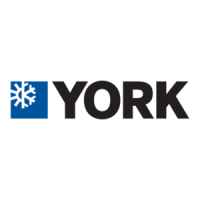2
Unitary Products Group
The maximum and minimum conditions for operation
must
be observed to assure a system that will give maxi
-
mum
performance with minimum service.
Table 1 – Application Limitations
Ambient
Air T
emperature
on Outdoor Coil
Air T
emperature on
Indoor Coil
Min.°DB
Max.
°DB
Min.
WB
Max.
WB
50 120 57 72
CHECK ELECTRICAL POWER SUPPLY
The
electrical power should be checked to determined if
adequate power is available, and near constant voltage
can be maintained. If there is any question concerning
the power supply, contact the local power company for
corrections;
otherwise, unsatisfactory performance may
result.
SELECTING EQUIPMENT LOCATIONS
Several
important factors must be considered before se
-
lecting
the best site for the air conditioning outside unit:
Distance to indoor coil
Proximity to the structure
Proximity to vents and exhaust systems
Ability to service
Sound transmission
Air circulation
Wind direction
Relationship between structure, sun, and unit
Distance from power source
W
ater drainage
Local codes
Locate
the outside unit near enough to the indoor coil vi
-
cinity
to eliminate lengthy refrigerant line runs. Do not lo
-
cate
the outside unit so it discharges air under eaves or
gutters.
Rain or snow melt–of
f should not be able to run
off
a roof and down upon the unit.
Be sure vents are not
located
upwind from the outside unit.
A
minimum clearance of 18 inches is required for service
at the control panel and compressor compartments ac-
cess.
A 10 inch clearance is required for the air inlet to the
outdoor
coil around the perimeter of the unit. The air dis
-
charge
of the unit requires a 60
inch clearance between
the
top of the unit and any obstruction. See Figure 1.
The
length of the refrigerant tubing,
between the outdoor
unit and indoor coil, should be as short as possible to
avoid
capacity and ef
ficiency loss.
Excessive spacing of
the
outside unit from the home can lead to the refrigerant
lines
being restricted by
trampling or by being punctured
by
lawn mowers. L
ocat
e u
ni
t a
wa
y f
ro
m b
edroo
m w
indows
or
o
ther room
s w
her
e s
oun
d m
igh
t be o
bjectionable.
Adverse effects of prevailing winds, blowing snow or
sleet
on the outdoor coil can be eliminated by placing the
outside
unit
where the wind does not blow across the unit.
Trees,
shrubs, corners
of buildings and fences standing
off
from the coil can reduce capacity loss due to wind chill
effect.
Provide
ample clearance from shrubs to allow
adequate
air to pass across the outdoor coil without leaves or
branches
being pulled into the coil.
Consideration should be given to the distance and rout
-
ing
of electrical service that would have to be run to
con
-
nect
the outside unit.
It
is recommended the outside unit be mounted on a con
-
crete
pad. T
op of pad should be two inches above grade.
OUTDOOR UNIT
After the site has been selected a concrete base pad
should
be provided. The concrete pad should not come in
contact with the foundation or side of the structure be-
cause sound may be transmitted to the residence. The
concrete
pad need not be any larger than the outside di
-
mensions of the outdoor unit. The concrete pad should
be
located far enough away from the structure so the out
-
side unit is not closer than its minimum distances. See
Figure 1. Set the outside unit upon the pad with care to
avoid
damage.
Do
not remove the protective caps or plugs from the
unit
refrigerant
connections until the refrigerant lines
are
run and
ready for final connection. If this proce
-
dure
is not observed, dirt and other particles will get
into
the system and plug various orifices and small
tubes.

